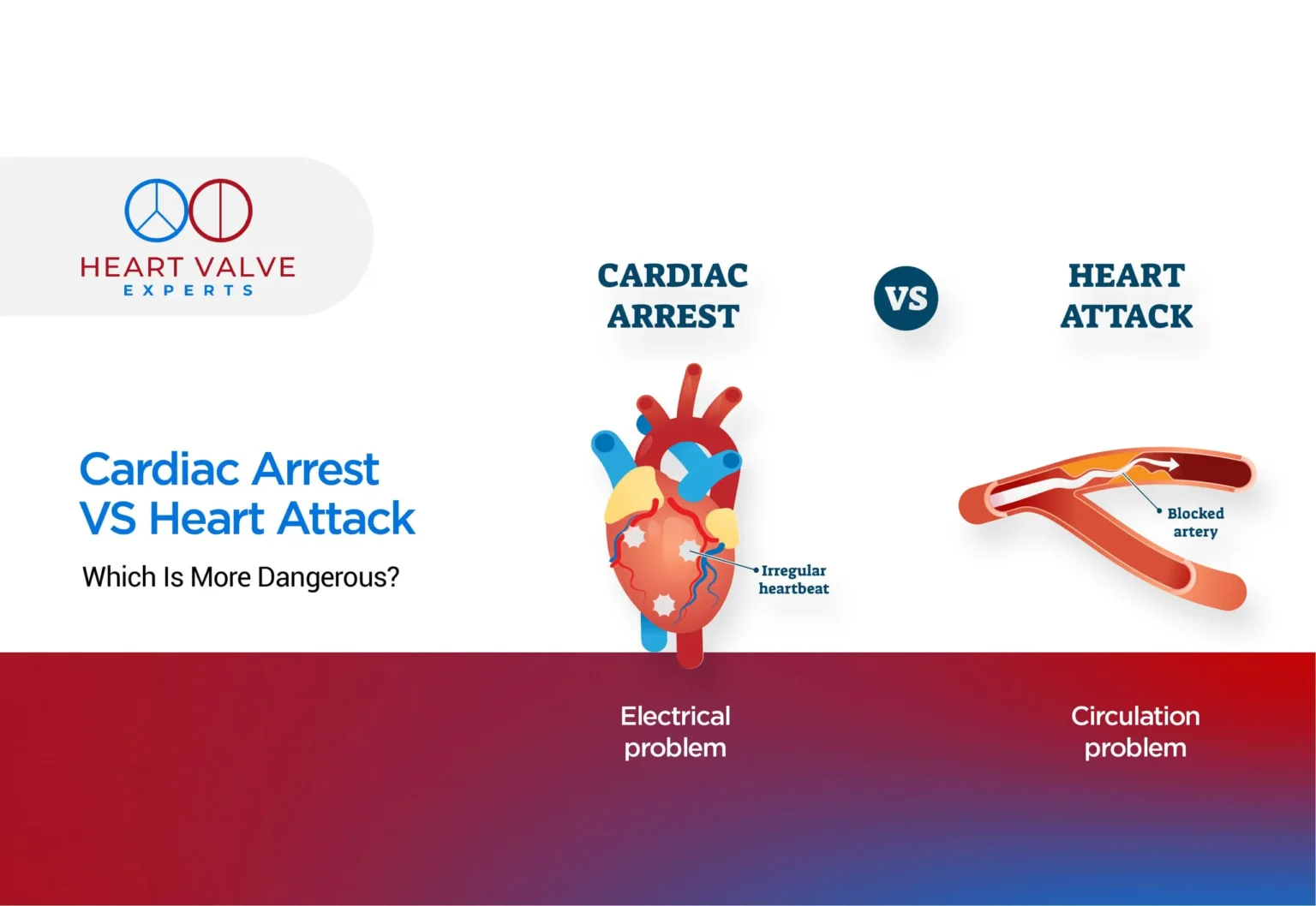When someone collapses suddenly, most people wonder if it is a heart attack or cardiac arrest. These terms are often confused, but they describe two very different medical emergencies. A heart attack occurs when blood flow to the heart muscle is blocked, while cardiac arrest happens when the heart suddenly stops beating. Understanding the difference between the two can save lives.
You may also ask, which is more dangerous heart attack or cardiac arrest? Both are serious, but cardiac arrest is immediately life-threatening because it causes the heart to stop pumping blood, leading to death within minutes if not treated. A heart attack can trigger cardiac arrest, but it usually allows more time for medical intervention. Knowing the signs, causes, and emergency response steps for each condition is crucial when every second counts.
What Is a Heart Attack?
A heart attack occurs when blood flow to part of the heart muscle is suddenly blocked, typically by a blood clot. This prevents oxygen-rich blood from reaching the heart muscle, causing tissue death if not treated promptly.
What Happens During a Heart Attack:
- Blood clot blocks coronary artery
- Heart muscle begins dying from lack of oxygen
- Heart usually continues beating (unlike cardiac arrest)
- Damage progresses over time without treatment
Common Causes:
- Coronary artery disease – cholesterol and fat buildup in arteries
- Plaque rupture – triggers blood clot formation
- Coronary artery spasm – temporary artery tightening
Major Risk Factors:
- Lifestyle factors: Smoking, obesity, physical inactivity
- Medical conditions: Diabetes, high blood pressure, high cholesterol
- Demographics: Men over 45, women over 55
- Family history: Genetic predisposition to heart disease
- Other factors: Chronic stress, excessive alcohol consumption
Think of a heart attack as a “plumbing problem” – the pipes (arteries) get clogged, but the pump (heart) keeps trying to work.
What Is a Cardiac Arrest?
Sudden cardiac arrest is an electrical malfunction causing the heart to suddenly stop beating effectively. Unlike a heart attack (circulation problem), cardiac arrest is an electrical system failure.
What Happens During Cardiac Arrest:
- Heart’s electrical system malfunctions
- Heart stops pumping blood immediately
- Blood flow to brain and organs ceases
- Person loses consciousness within seconds
Common Causes:
- Arrhythmias – abnormal heart rhythms (especially ventricular fibrillation)
- Heart muscle disease – cardiomyopathy
- Heart failure – weakened heart muscle
- Severe trauma – electric shock, drowning
- Drug overdose – cocaine, stimulants
- Congenital defects – structural heart problems
Key Characteristics:
- Existing heart conditions – prior heart attack, heart failure, arrhythmias
- Genetic factors – family history of sudden cardiac death
- Electrolyte imbalances – low potassium or magnesium
- Substance use – drugs or excessive alcohol
- Severe physical stress – intense exercise, major blood loss, or extreme illness
- Demographics – more common in older adults but can occur in young athletes
Cardiac arrest is like an electrical short circuit; it strikes without warning. One moment you are fine, the next you are unconscious and the entire system shuts down instantly.
What Is The Difference Between Heart Attack And Cardiac Arrest
| Aspect | Heart Attack | Cardiac Arrest |
| Cause | Blocked blood flow | Electrical failure |
| Onset | Gradual (minutes/hours) | Sudden (seconds) |
| Heart Status | Usually keeps beating | Stops beating |
| Consciousness | Usually remains conscious | Immediate unconsciousness |
| Symptoms | Chest pain, sweating | Collapse, no pulse |
| Treatment | Medications, angioplasty | CPR, defibrillation |
| Time Window | Usually a few hours for treatment | Minutes before brain damage |
Which Is Worse: Cardiac Arrest or Heart Attack?
In the Indian context, cardiac arrest is significantly more dangerous and far harder to survive compared to a heart attack.
Cardiac Arrest: Why It Is More Dangerous in India
Cardiac arrest is a sudden electrical failure of the heart that stops blood flow to the brain and vital organs within seconds. In India, the survival chances are extremely low:
- Survival Rate: Less than 10% of out-of-hospital cases survive to hospital discharge, according to studies conducted in South India.
- Bystander CPR: Performed in only 2% to 5% of cases, which is alarmingly low compared to developed nations.
- Critical Window: Brain damage begins within 4 to 6 minutes, and death occurs in 8 to 10 minutes without intervention.
- Annual Impact: India sees hundreds of thousands of sudden cardiac arrest cases every year, but most go unrecorded due to lack of centralized data and low emergency response infrastructure.
Heart Attack: Comparatively Better Survival Rates
While heart attacks are serious, the chances of survival are much higher because:
- Treatment Window: There are usually several hours to act and start treatment.
- Advanced Therapies: Angioplasty, clot-busting drugs, and other hospital interventions save many lives when started promptly.
- Outcome Improvement: With proper hospital care, survival rates for heart attacks are considerably higher than for cardiac arrest.
Why Cardiac Arrest Is More Deadly
- No Warning: Often occurs without symptoms, making it unpredictable.
- No Time: Requires CPR and defibrillation within minutes, which is rarely available outside hospitals in India.
- Poor Emergency Access: Lack of public awareness, minimal availability of AEDs, and low rates of CPR training make outcomes worse.
- Lower Success Rate: Even with the best response, chances of survival are slim compared to heart attack patients.
Symptoms: How to Tell Them Apart
Heart Attack Symptoms:
1. Classic Symptoms (Most Common in Men and Women)
- Chest pain or discomfort, pressure, squeezing, or fullness
- Pain radiating to arms, neck, jaw, or back
- Shortness of breath
- Nausea, sweating, or lightheadedness
2. Symptoms That May Differ in Women
- Pain in the back, jaw, or stomach (sometimes without chest pain)
- Unusual fatigue or weakness
- Shortness of breath as the primary symptom
3. Silent Heart Attack
- Occurs without obvious symptoms
- May feel like mild indigestion, fatigue, or discomfort
- More common in diabetics and older adults, but can happen to anyone
Cardiac Arrest Symptoms:
- Sudden collapse
- No pulse
- No normal breathing
- Complete unresponsiveness
- May briefly convulse or gasp (involuntary responses)
Key heart attack cardiac arrest difference:
- Heart attack: Person usually conscious and can communicate
- Cardiac arrest: Immediate unconsciousness and unresponsiveness
What to Do in an Emergency?
For Heart Attack:
- Call emergency services immediately – don’t wait for symptoms to improve, get in touch with a heart specialist in Mumbai
- Give aspirin (325mg) if conscious and not allergic – have them chew slowly
- Keep calm and comfortable – preferably sitting upright
- Loosen tight clothing
- Monitor vital signs until help arrives
- Be ready for CPR if they become unconscious
For Cardiac Arrest:
- Check responsiveness – tap shoulders, shout
- Call emergency services immediately
- Begin CPR – push hard and fast on chest center, at least 2 inches deep and 100-120 compressions per minute
- Use AED if available as soon as possible
- Don’t stop CPR until responders arrive
Can One Lead to the Other?
Yes, a heart attack can trigger cardiac arrest, but the reverse is rare. Here’s how they are connected:
How Heart Attacks Can Lead to Cardiac Arrest:
- Disrupted Electrical System: Damage to the heart muscle interferes with its normal electrical signals.
- Arrhythmias Develop: Dangerous rhythms like ventricular fibrillation can occur.
- Severity Matters: More likely during large or critical-area heart attacks.
- Timing: May happen during the acute attack or recovery phase.
Other Conditions That Can Cause Cardiac Arrest (Not Heart Attack):
- Cardiomyopathy (thickened or weakened heart muscle)
- Advanced heart failure
- Congenital heart defects
- Severe infections impacting the heart
- Electrical abnormalities unrelated to blockages
Key Takeaways:
- Most heart attacks do not lead to cardiac arrest.
- When cardiac arrest happens, a heart attack is often the underlying cause.
- Cardiac arrest almost never triggers a heart attack.
- Both conditions cause significant heart damage and require urgent care.
Why This Matters:
This is why heart attack patients are closely monitored in cardiac care units, where immediate response to sudden cardiac arrest is possible.
Prevention Tips for Both Conditions
Preventing heart attack and cardiac arrest starts with managing overall heart health. While the two conditions differ, many preventive strategies overlap.
Heart Attack Prevention:
Focus on reducing plaque buildup and improving circulation.
- Eat a Heart-Healthy Diet: Include fruits, vegetables, whole grains; limit saturated fats and sodium.
- Exercise Regularly: Aim for at least 150 minutes of moderate activity per week.
- Quit Smoking: Eliminate tobacco use immediately for better heart health.
- Maintain a Healthy Weight: Prevent obesity-related heart strain.
- Manage Existing Conditions: Control diabetes, blood pressure, and cholesterol.
Cardiac Arrest Prevention:
The goal is to reduce the risk of sudden electrical failure in the heart.
- Schedule Regular Cardiology Checkups: Detect heart problems early.
- Consider Genetic Testing: Important if there’s a family history of sudden cardiac death.
- Use ICDs (Implantable Cardioverter Defibrillators): For high-risk individuals.
- Avoid Illegal Drugs: Stay away from substances like cocaine and amphetamines.
Universal Strategies for Both:
These steps benefit overall cardiovascular health and improve survival chances.
- Manage Stress: Use relaxation techniques and ensure adequate sleep.
- Limit Alcohol Intake: Keep consumption moderate or minimal.
- Adhere to Medications: Take prescribed drugs as directed.
- Learn CPR and AED Use: Immediate action can save lives in an emergency.
- Get Regular Screenings: Identify and address risk factors early.
Conclusion
Cardiac arrest vs heart attack are both medical emergencies, but cardiac arrest is far more immediately life-threatening, with a 90% fatality rate compared to much better heart attack survival rates. The difference lies in the cause: heart attacks are circulation problems caused by blocked arteries, while cardiac arrest is an electrical failure that stops the heart instantly. Heart attack victims often remain conscious, but cardiac arrest victims collapse without warning. Both require immediate medical attention, and every second counts.
Recognizing the warning signs, learning CPR, and knowing how to use an AED can save a life. Maintain cardiovascular health, act fast, and never hesitate to call emergency services or cardiologists in Mumbai. For expert guidance on heart health and advanced care options, connect with Heart Valve Experts today. Your heart deserves the best care, so take action before it is too late.
FAQs
No, a heart attack is a blockage in blood flow, while cardiac arrest is when the heart suddenly stops beating.
It occurs when the heart’s electrical system malfunctions, causing an irregular heartbeat and stopping blood circulation.
Cardiac arrest is more dangerous as it causes sudden death without immediate CPR or defibrillation.
Yes, a severe heart attack can trigger cardiac arrest by disrupting the heart’s electrical system.
Call emergency services and start CPR immediately; use an AED if available.

